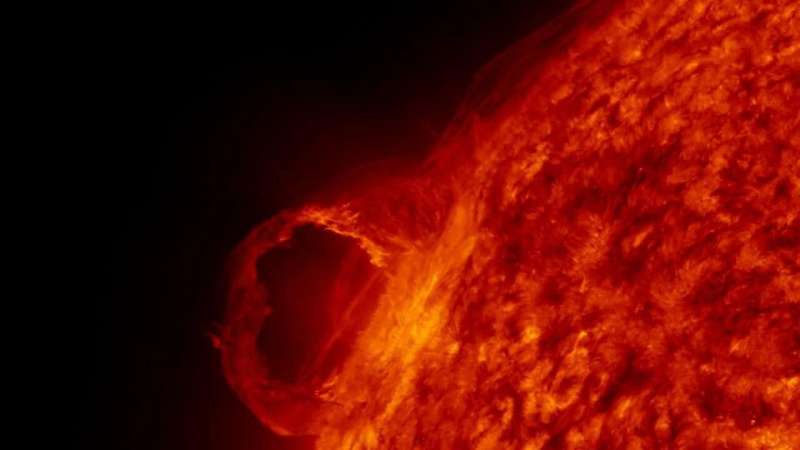Analyzing turbulent diffusion effect in the solar flare current sheet

Researchers from the Yunnan Observatories of the Chinese Academy of Sciences have investigated the turbulent properties in the large-scale solar flare current sheet (CS).
They quantitatively analyzed the magnetic reconnection rate, diffusivity, dissipation scale, turbulence amplitude, etc., after the appearance of turbulence caused by tearing instabilities. They found that turbulence can effectively broaden the CS width and bring an extra dissipation effect in the CS.
The findings were published in Research in Astronomy and Astrophysics on May 31.
A solar flare is one of the most energetic events in the solar system, in which up to 1032 ergs of magnetic energy is released via magnetic reconnection. This large-scale current sheet connecting to the flare and the erupting flux rope is the main place for the magnetic reconnection process.
Classical theories predict a width of the CS corresponding to the ion inertial scale of tens or hundreds of meters, while many observations found an associated width of 104 to 105 km.
The huge discrepancy can be related to the turbulence occurring in the CS. Thus the accurate estimation of the energy dissipation provoked by turbulence is crucial to understanding the fast energy release in the solar flare.
In this study, the researchers utilized 2D high-resolution magnetohydrodynamic numerical simulations, based on the standard flare model in the gravitationally stratified solar atmosphere. The magnetic reconnection rate showed an apparent increase due to the appearance of tearing instabilities.
They found that the appearance of the turbulence was equivalent to adding an extra dissipation term into the induction equations, which could drastically enlarge the local diffusivity in the CS. "According to the spectrum analysis, we calculated the related dissipation scale of 100–200 km, which was much higher than the ion inertial scale. It corresponded to the width of the secondary reconnection CS between the merging plasmoids," said Zhang Yining, first author of the study.
In addition, they calculated the general width of the current sheet to be 1500–2500 km, which was consistent with the observational results. Indeed, the CS width often found in observations is proven to be relevant with the Taylor scale from Biskamp's theory.
"The termination shock at the flare loop top can somewhat amplify the turbulence amplitude. The amplification factor is related to the local geometry of termination shock, and the termination shock is shown to have a higher heating efficiency rather the kinetic energy transfer," said Dr. Ye Jing, corresponding author of the study.
This study illuminates the details of the dissipation mechanism of the magnetic reconnection in the presence of turbulence in the solar flare.
More information: Yining Zhang et al, Two-dimensional modeling of the tearing-mode-governed magnetic reconnection in the large-scale current sheet above the two-ribbon flare, Research in Astronomy and Astrophysics (2022). DOI: 10.1088/1674-4527/ac751a
Provided by Chinese Academy of Sciences





















